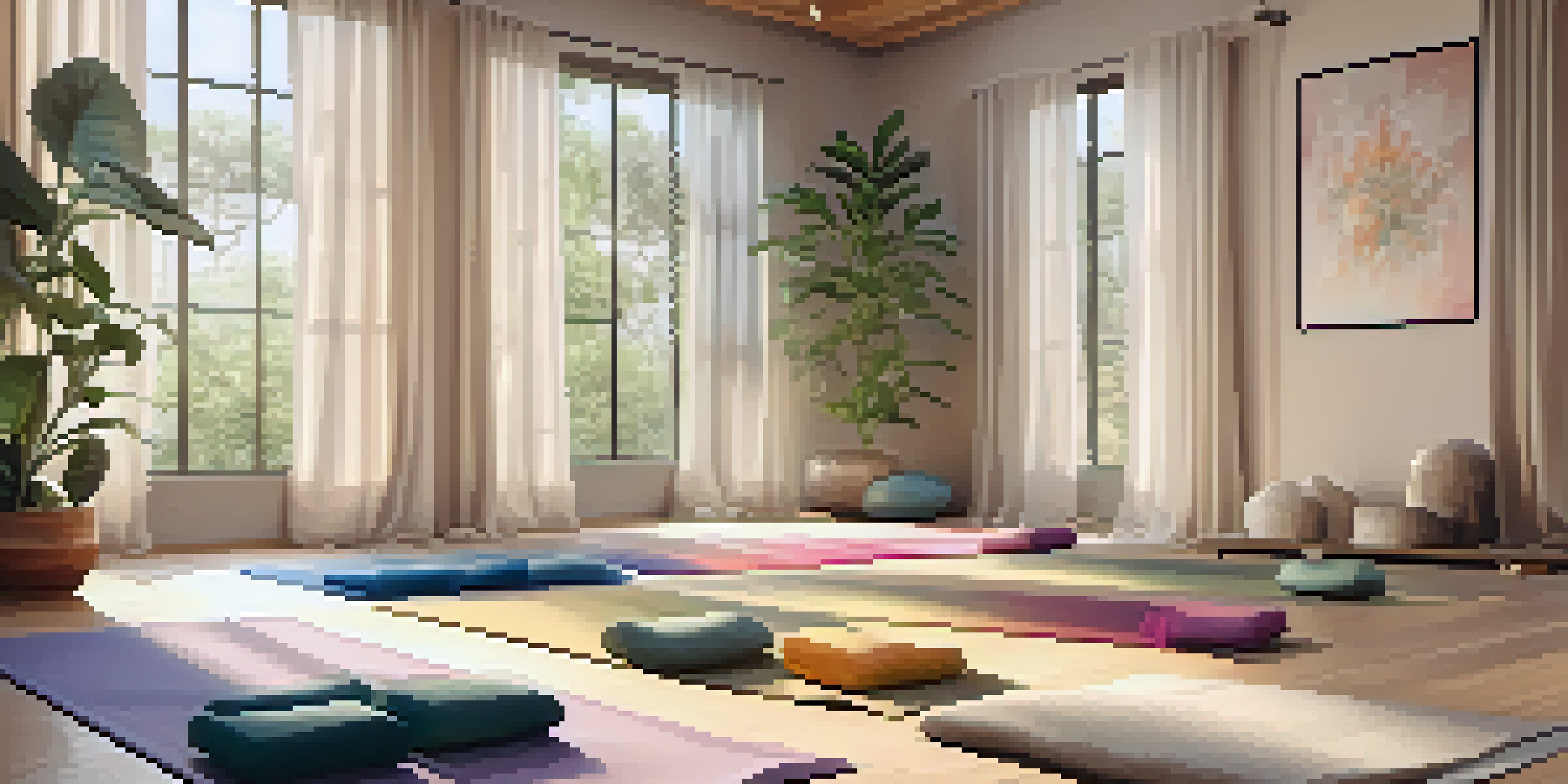The Healing Power of Restorative Yoga for Stress Relief

Understanding Restorative Yoga and Its Benefits
Restorative yoga is a gentle form of yoga that focuses on relaxation and healing. It involves holding poses for extended periods, often supported by props like blankets and bolsters. This practice encourages deep relaxation, making it an effective tool for stress relief and mental clarity.
Yoga is the journey of the self, through the self, to the self.
Unlike more active styles of yoga, restorative yoga allows your body to unwind completely, which can lead to a decrease in stress hormones. Many practitioners find that just a few sessions can help them manage anxiety and foster a sense of calm. This gentle approach can truly transform how you respond to life's challenges.
The practice creates a safe space for self-exploration and mindfulness, which can be particularly beneficial in our fast-paced lives. By prioritizing rest and relaxation, restorative yoga helps to reset your nervous system and rejuvenate your mind, preparing you to face daily stresses with renewed energy.
The Science Behind Stress Relief and Yoga
Research shows that yoga can significantly lower levels of cortisol, the hormone associated with stress. This is particularly true for restorative practices, which promote deep relaxation and mindfulness. By calming the mind and body, restorative yoga helps to disrupt the cycle of stress and anxiety.

Additionally, restorative yoga encourages deep breathing and mindfulness, techniques that have been proven to activate the parasympathetic nervous system. This 'rest and digest' mode counteracts the body's stress response, allowing for deeper relaxation and recovery. Understanding this connection helps to reinforce the value of integrating yoga into your stress management toolkit.
Restorative Yoga for Stress Relief
Restorative yoga promotes deep relaxation, helping to lower stress hormones and improve mental clarity.
Practicing restorative yoga not only benefits your mental health but also supports physical healing. By reducing muscle tension and promoting better circulation, it enhances overall well-being. This interconnectedness of body and mind underscores the powerful role that restorative yoga can play in stress relief.
Creating the Perfect Environment for Restorative Yoga
To maximize the benefits of restorative yoga, it's essential to create a calming environment. A quiet, clutter-free space with soft lighting can help cultivate a serene atmosphere. Incorporating soothing elements like essential oils or gentle music can further enhance your practice.
The mind is everything. What you think, you become.
Consider using props like bolsters, blankets, and eye pillows to support your body in various poses. These props not only provide comfort but also encourage deeper relaxation, allowing you to fully surrender into each position. The right setup can make all the difference in your experience.
Lastly, setting an intention before your practice can guide your focus and enhance your connection to the present moment. Whether it's letting go of tension or simply finding peace, having a clear purpose can deepen the restorative effects of your yoga practice.
Common Restorative Yoga Poses for Stress Relief
Several restorative yoga poses are particularly effective for relieving stress. Child's Pose, for example, encourages deep breathing and relaxation while gently stretching the back. This pose can create a sense of safety and grounding, making it an excellent choice for beginners.
Another beneficial pose is Supported Bridge Pose, where you elevate your hips with a bolster. This opens the chest and promotes heart health while allowing the body to release tension. Each pose in restorative yoga is designed to support relaxation, so feel free to explore and find what resonates with you.
Creating a Calming Space
Establishing a serene environment with props and soothing elements enhances the restorative effects of yoga.
Finally, Legs-Up-the-Wall Pose is a fantastic way to calm the nervous system. By lying on your back with your legs resting against the wall, you encourage blood flow and promote relaxation. This pose can be a simple yet powerful addition to your restorative routine.
Incorporating Mindfulness into Your Practice
Mindfulness plays a crucial role in restorative yoga, as it encourages you to focus on the present moment. By practicing awareness of your breath and body sensations, you can deepen your relaxation and enhance stress relief. This heightened awareness helps to create a more meaningful connection between mind and body.
During your practice, try to let go of distractions and cultivate a sense of acceptance. This might mean acknowledging any racing thoughts without judgment and gently guiding your focus back to your breath. Mindfulness in restorative yoga not only calms the mind but also fosters a sense of peace and clarity.
Incorporating mindfulness techniques, such as body scans or guided imagery, can further enhance your experience. These practices encourage you to tune in to your body and release any accumulated tension, paving the way for a more restorative session.
The Role of Breath in Restorative Yoga
Breath is a central component of restorative yoga, acting as a bridge between mind and body. Focusing on your breath can help anchor your awareness and bring you back to the present moment. By practicing deep, intentional breathing, you signal to your body that it’s time to relax.
Using techniques like diaphragmatic breathing can enhance your restorative practice. This involves breathing deeply into your belly rather than your chest, which promotes relaxation and reduces stress. The rhythmic nature of breath work can calm the mind and create a sense of ease.
Mindfulness and Breath Connection
Integrating mindfulness and breath techniques into your practice deepens relaxation and fosters a meaningful mind-body connection.
As you progress in your practice, experiment with different breathing techniques to find what resonates most with you. Whether it’s counting your breath or practicing extended exhales, connecting with your breath will deepen your relaxation and overall experience in restorative yoga.
How to Start Your Restorative Yoga Journey
Starting your restorative yoga journey can be simple and rewarding. Begin by setting aside dedicated time each week to practice, even if it’s just 20-30 minutes. Consistency is key, as regular practice will help you cultivate a deeper connection with yourself and your body.
You don’t need to be an expert to start; beginner-friendly resources are widely available. Consider attending a restorative yoga class in your area or following online tutorials that guide you through poses. The community aspect of yoga can also provide additional support and motivation.

Lastly, remember to listen to your body and honor your limits. Restorative yoga is about nurturing yourself, so allow your practice to be a reflection of your unique needs. Embrace the journey, and enjoy the healing benefits that restorative yoga has to offer.